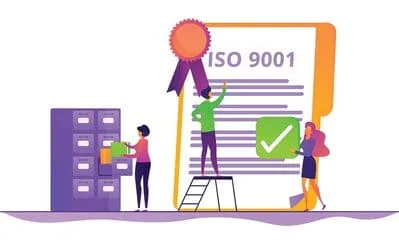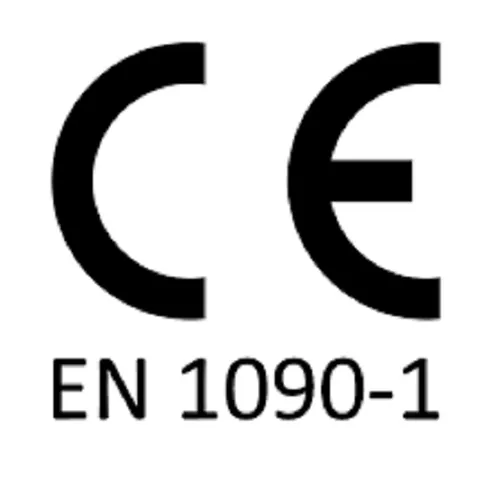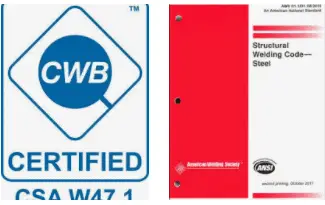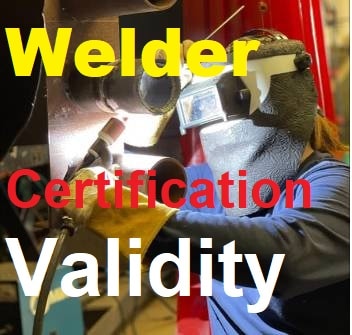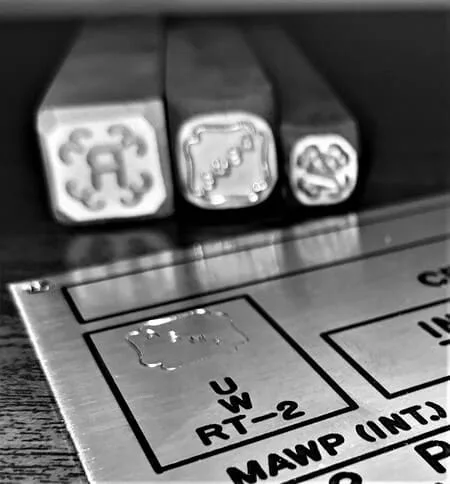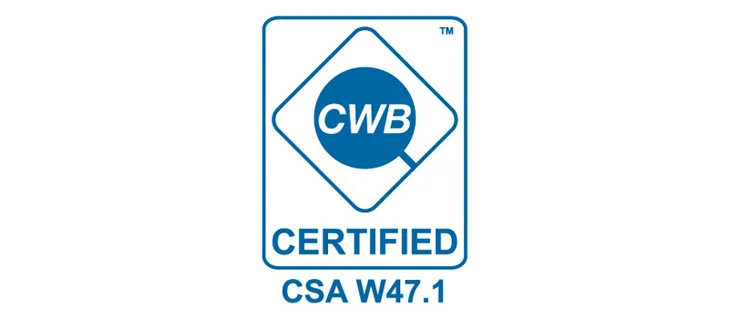What is ISO 3834 Certification?
DIN EN ISO 3834 specifies the requirements for a specialist welding company for fabrication and regulates the principles for quality assurance of welded products.
Manufacturers of fusion-welded components and constructions secure their worldwide competitiveness with certification according to the internationally recognized standard that meets the quality and safety requirements.
ISO 3834 vs ISO 9001
Welding requires special requirements with regard to quality assurance, which is why welding falls under the term “special process” of ISO 9001.
In order to transfer the requirements of the standard for quality management systems to the special process of welding, a separate series of standards DIN EN ISO 3834 has been compiled, which defines the “Quality requirements for fusion welding of metallic materials”.
Since quality management standards such as DIN EN ISO 9001 only deal with definable processes, further standards are written down for individual “special processes”. In this context, ISO in Geneva developed ISO 3834.
The term “special process” describes a process that cannot be fully proven by mere process monitoring within the meaning of ISO 9000. No one can tell me for sure what happens inside the seam during welding, “you can’t see in”.
For example, it is impossible for a welding supervisor or a weld seam tester to prove perfect quality without destructive material testing.
However, since destructive testing would render a welded component unusable, the process of checking welds on metallic materials requires a separate procedure.
In order to obtain proof of quality and conformity for components made of steel, aluminum and their alloys in connection with EN 1090 or others, documentation obligations and quality requirements of the respective level of ISO 3834 must be complied with.
Applicability of the standard
The standard is not limited to special applications, welding processes or materials and is therefore applicable to all welding applications. The standard can stand alone or be co-certified as part of ISO 9001 certification.
Read more: ISO 3834 Certification Guide.
Structure of DIN EN ISO 3834
DIN EN ISO 3834 consists of a total of 5 parts:
- Part 1: Criteria for selecting the appropriate level of quality requirements,
- Part 2: Comprehensive quality requirements,
- Part 3: Standard quality requirements,
- Part 4: Basic quality requirements,
- Part 5: Documents whose requirements must be met to demonstrate compliance with the requirements of DIN EN ISO 3834-2, DIN EN ISO 3834-3 or DIN EN ISO 3834-4.
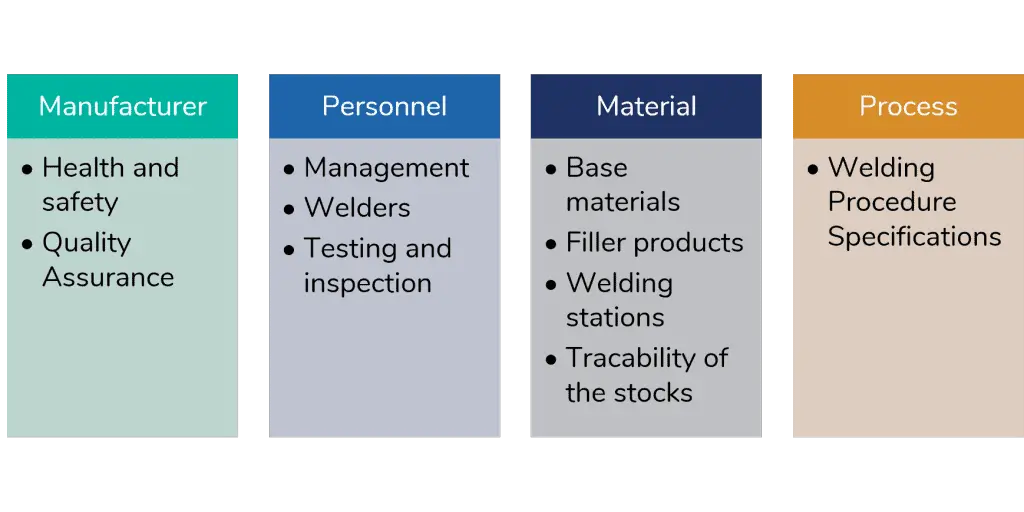
Difference between ISO 3834-2 and ISO 3834-3
ISO 3834-2 and ISO 3834-3 are two of the main standards for welding quality management systems. While both are related to welding, there are some important differences between them that it is important to understand in order to properly utilize them.
The first, ISO 3834-2, is an auditing standard that focuses on the management system associated with welding processes. It aims to uphold a high level of quality by ensuring that organizations have a reliable system in place for producing satisfactory results.
The main difference is:
- ISO 3834-2: Documented plans and records are required.
- ISO 3834-3: Records and maintenance are recommended.
Is ISO 3834 mandatory?
ISO 3834 is a standard for quality requirements for fusion welding of metallic materials. It is an international standard and provides guidance on the quality system that fabricators must implement to meet the requirements of EN1090 and EN15085 certification.
Fabricators who make construction as per these standards can benefit significantly from ISO 3834 certification as it helps to ensure that welding processes are carried out in a consistent and reliable manner.
The standard outlines the responsibilities of both management personnel and welders, detailing what is required to be done in order to produce consistently high-quality results in terms of the welds themselves and any additional activities carried out by welding personnel.
Additionally, it encourages the implementation of procedures which are based on risk identification, evaluation, control and review throughout every stage of production. The resulting improvements in performance can lead to increased confidence amongst customers that their product will meet all specified requirements.
Furthermore, having certified welders with ISO3834 qualification shows potential customers that the company follows strict quality control processes, which can help increase customer trust and loyalty.
Objectives of the ISO 3834 Standard
The main Objectives of the ISO 3834 Standard are:
- Definition and management of quality requirements for welding work.
- Provision of regulations and regulations to meet welding quality requirements.
- Ensuring the competence of the company and applying appropriate control of the welding process.
- The use of appropriate processes to demonstrate the ability to produce quality products.
Advantages of certification according to DIN EN ISO 3834
Advantages of certification according to ISO 3834 for the manufacturer are:
- Fulfillment of welding quality requirements by providing regulations and regulations,
- Definition and management of quality requirements for welding work,
- Ensuring the competence of your company by applying appropriate welding process control,
- Minimization of error costs,
- Increase your competitiveness.
Elements of the ISO 3834 Standard
The DIN EN ISO 3834 standard is divided into five parts and deals with quality requirements in welding technology.
- DIN EN ISO 3834-1 is provided in order to be able to select a suitable level of documentation (level 2-4, two is the highest level, 4 is the smallest).
- The following sheets DIN EN ISO 3834 2-4 specify quality requirements and documentation obligations. The second level describes comprehensive requirements, the third standard requirements and the fourth elementary requirements. A “first” stage therefore does not exist.
- The sheet DIN EN ISO 3834-5 describes documents whose requirements must be proven for the respective level.
Possibility of certification according to DIN EN ISO 3834
Various certification companies offer an audit and issuance of a certificate in connection with DIN EN ISO 3834. However, there are no legal requirements for welding companies. The certification is therefore absolutely voluntary for everyone.
However, advantages can arise for supplier companies if customers prefer companies with such certificates.
The supplier has already proven that it can work according to defined quality standards. The customer can count on a higher quality standard because a QM system adapted to the company is established.
Furthermore, there are also industrial customers who order exclusively from manufacturers with successful 3834 auditing. Thus, certification can be worthwhile and should be considered on a case-by-case basis.
DIN EN ISO 3834-1:
This Part 1 contains the criteria to be observed for the selection of the appropriate level of quality requirements for fusion welding of metallic materials, from the three specified stages in Part 2, -3 and -4. It applies to production, both in workshops and on construction sites. DIN EN ISO 3834-2, -3, and -4 may be used alone or in conjunction with ISO 9001:2000 by the manufacturer.
DIN EN ISO 3834-2, -3 and -4:
These parts contain complete sets of quality requirements for process control for all welding processes (for a single process or in a specified combination) and define quality requirements for fusion welding in workshops and/or construction sites.
DIN EN ISO 3834-5:
This part contains the normative references. This part of DIN EN ISO 3834 does not specify any requirements for a quality management system. But section 6 contains elements of a quality management system, the inclusion of which supplements DIN EN ISO 3834 and can only be applied in conjunction with Parts 2, -3 and -4.
ISO/TR 3834-6
In addition, the standard part ISO/TR 3834-6 “Quality requirements for fusion welding of metallic materials – Part 6: Guideline for the introduction of ISO 3834” will provide guidance in the implementation of quality assurance systems.
ISO 3834 quality requirements for welding
The international standard DIN EN ISO 3834 specifies the “Quality requirements for fusion welding of metallic materials”. It applies to all welding applications, welding in series as well as individual production, during assembly as well as in repair.
DIN EN ISO 3834 is suitable for companies that do not work in the field of construction authorities and therefore do not requirecertification according to DIN EN 1090, e.g. companies in mechanical engineering or road vehicle construction.
With certification according to DIN EN ISO 3834, you can prove that your products meet international normative requirements. For your customers, this means the certainty that your company can carry out welding work professionally.
For you as a company, certification brings not only legal certainty, but also the continued existence of your competitiveness and the opportunity to participate in lucrative public tenders.
DIN EN ISO 3834 and DIN EN 1090 – Connection
A welding company certified according to DIN EN 1090 is obliged to operate quality assurance within the meaning of DIN EN ISO 3834 and, if necessary, to document it.
For the selection of the appropriate level, a recommendation is written down in DIN EN 1090. Here, one orients oneself to the required embodiment classes (EXC) of the product to be manufactured.
- EXC 1 -> ISO 3834-4 -> Simple structures on private land,
- EXC 2 -> ISO 3834-3 -> structures not classified in EXC 1, 3 or 4,
- EXC 3-4 -> ISO 3834-2 -> Complex structures and those on public land.
Summary
The specified quality requirements according to the EN ISO 3834 series of standards are suitable for demonstrating the competence of a welding manufacturing company according to its selected quality level in order to create the prerequisite for meeting the required quality requirements.
In order to build trust and achieve international recognition, certification by an accredited certification body is recommended. This avoids multiple certifications with manufacturers working internationally or in different sectors and achieves cost savings. The importance of the new DIN ISO 3834 series of standards will continue to increase due to its international orientation.
- DIN EN ISO 3834 is based on DIN EN ISO 9001 and deals with special processes that cannot be qualitatively proven without further ado.
- Certification possible, but no legal basis.
- However, certification makes sense in special cases.
- Appropriate level can be determined in other standards
- The first part of the standard can also give an indication of which level is applied.

